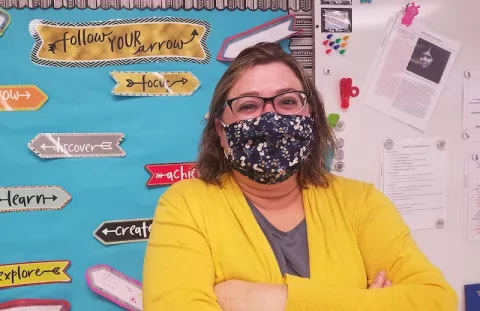On a Thursday back in March, Jaime Halbmaier- Stuart, a fourth-grade teacher at Lebanon Elementary School in Maine, found herself in a meeting with colleagues and administrators. The message that day: “We may close. … Prep these things for the kids. … We won’t know until tomorrow.” The next day, Halbmaier- Stuart was directed to have students pack their computers, chargers, and any essentials and was told, “We won’t be coming back on Monday.”
“This was one of the most unnerving times I have ever experienced,” she adds. “Part of my identity is that I’m a fourth-grade classroom teacher. … We live and breathe our schools and our students, so to not be able to see them every day in person and make sure they’re okay was trying— and that’s a small word for it.”
Halbmaier-Stuart, like millions of educators from across the country and around the globe, suddenly found herself making the switch from in-person to distance learning.

As a former education technician of five years who supported literacy and math at a Title I school, she considers herself to be tech savvy. Before the coronavirus pandemic, she was already using Google Classroom; Newslea, a reading comprehension platform; Kahoot, a game-based learning platform known for its trivia quizzes; and more.
During the pandemic, the situation became overwhelming. “We kept getting a lot of information thrown at us,” explains Halbmaier-Stuart. “It was ‘let’s try this’ or ‘let’s try that because it’s cool.’ It was this onslaught of information and it got to be incredibly overwhelming very fast.”
A simple internet search on “education technology (or ed tech) for teachers” can easily bring thousands of pages of results with eye-catching titles such as, “101 Hottest Ed Tech Tools,” “Top 6 Education Technology Trends Right Now” or “27 Tech Tools Teachers Can Use to Inspire Classrooms.” It’s hard to digest all that information with little guidance on how each tool will enhance student learning. This is where NEA comes in.
When the pandemic hit, NEA developed a series of ed tech webinars and tapped into their membership—teacherleaders— to help their peers cut through the clutter. And, it’s where Halbmaier-Stuart, as a member of the NEA-affiliated Maine Education Association, found much-needed relief.
Michigan Educators Drive Member-to-Member Support
“This is union members as teacher-leaders supporting other union members,” says Chris Thomas, who teaches science at Scarlett Middle School, in Ann Arbor, Mich., and coordinates blended learning for the school district. “We’re positioned to be super relevant, sharing ideas and frameworks for thinking that people can use the next day to support themselves, their colleagues, and their students in these challenging times.”
Over the span of 20 years, Thomas has developed a deep portfolio of professional learning experiences around the thoughtful integration of technology to support student achievement. He has trained countless educators and has built a network of teacher-leaders who are experts in blended learning and ed tech. He now supports thousands of educators nationwide as they navigate the murky waters of distance learning.

So far, nearly 20,000 educators from across the country and overseas have benefited from the webinar series, which is delivered through the state and national unions.
There is no magic to the sessions—organized around topics such as effectively using Google Classroom, teaching math at a distance, providing differentiated instruction and accommodation, addressing social-emotional needs, and planning a week of remote teaching.
The key to success is in the attention paid to pedagogy, says Ellen Brooks, a sixth-grade teacher in her second year at Monroe Public Schools who previously taught first grade in Ann Arbor. She facilitates alongside Thomas.
“With all of these shifts that we’re making, we’re trying to say, ‘Here’s how you think about it and make it work for you in a meaningful context for your demographic.’”
Thomas adds, “Learning about Google Classroom is important, but it’s also important to know when are you going to use each tool; why; what are the different affordances; and how do you balance all these things as a designer of instruction for your students.”
The Webinar Series
Across the country, state associations are tapping into their membership to identify teacher-leaders who are experts in remote or hybrid instruction to help support their colleagues. The course offerings meet educators where they are; they are straightforward; and they are delivered by people who understand the challenges educators face, because they’re living it, too.
The webinars, hosted by NEA, cover a wide range of topic, such as Seesaw; “Tips and Tricks to Video Conferencing”; “Wellness Skills for Self-Care and Health” (tailored for education support professionals); and myriad others.
Sociology 101

Veronica Choe and Anna Gonzalez are middle school teachers (and roommates!) in Ann Arbor. The duo led a webinar in the fall on Schoology, a learning management system. Top takeaways educators learned that day?
• Get organized: Structure your course pages to help students find the information they need and keep on track with digital assignments.
• Help students navigate their coursework:
– House your material, such as lesson plans and instructions, on one page to help keep students focused;
– Add another level of socialization to virtual-learning spaces by allowing students to submit their responses in multiple ways;
– Create assignments that allow students to provide multiple means of expression and align with standardized or custom learning objectives;
and – Use various types of assessment questions to measure a student’s understanding.
• Open up discussions: Maintain meaningful student discussions and group work in different ways, including email, audio, and video.
“The goal is always for educators to have one tangible takeaway, whether that is a new teacher move, an SEL activity, thinking routine, or opportunity for students to discuss with each other, that they can modify or customize to fit the needs of their students,“ says Choe. “Additionally, I hope that other educators can pick up some time-saving strategies that are specific to distance learning … [and] be validated in their feelings that distance learning is VERY challenging and they are not alone. We must continue to set healthy boundaries for ourselves while we engage in this work. We cannot take care of our students if we neglect ourselves.“
Ed Tech Pedagogy
In addition to some of the how-tos of various platforms, webinars also focus on pedagogy. Michigan’s Leslee Bullock, a kindergarten teacher, and Kelsey Lafferty, a second-grade teacher, co-facilitated a webinar on “EdTech Pedagogy in Early Childhood” to help educators support their youngest learners.
“Kids are ready to discover at every turn, and so if we give them the tools and give them a little bit of guidance, they can do amazing things,” Bullock said during the webinar.
While each tool will look different based on grade level, subject matter, and the students in the class, the lessons shared during these webinars are intended to serve as best practices and can be applied to different grade levels.
Key takeaways for teachers working with young students include:
• Go slow. Similar to in-person teaching where manipulatives and routines are slowly rolled out, ed tech requires a slow roll out, too. If a tool can perform 10 functions, teach one at a time.
• Remove barriers by setting clear, concise, and consistent expectations, with a lot of modeling.
• Give yourself grace. Mistakes will be made; keep going.
The Association Advantage
For Jaime Halbmaier-Stuart, the webinars were what she needed as a professional. “I felt like I had support at the national level and that I wasn’t going through this alone—that is so important right now,” she says. “[The pandemic] has forced us to look at how we’re managing our time, delivering our content, and engaging our students to learn and be happy,” she says.
Learn More and Take Action
Watch dozens of NEA webinars at nea.org/webinars. Educators who participate are eligible to earn credit from their respective state associations.
Do you have an area of expertise or know someone who does? Contact your state affiliate’s professional development division to share your knowledge with fellow members.



